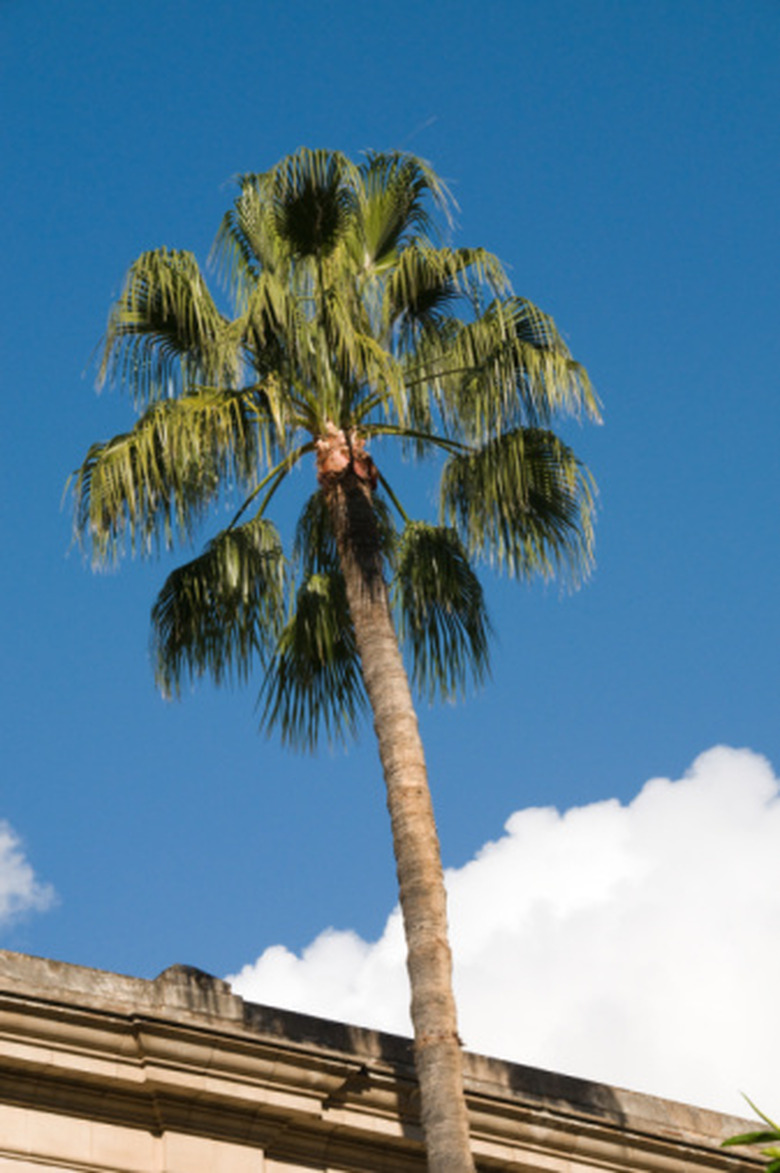Are Palm Trees Monocots?
Palm trees are members of Division Anthophyta of the plant kingdom. Division Anthophyta is composed of angiosperms, commonly called flowering plants. Angiosperms are divided into two classes: monocotyledons and dicotyledons, or monocots and dicots. Cotyledons are seed leafs that provide nutrients to embryo plants until seedlings can conduct photosynthesis on their own. Monocot plant seeds contain one cotyledon. Dicot plant seeds contain two cotyledons.
Palm Trees
Palm Trees
Palm trees are monocots, according to the University of California Museum of Paleontology. Even though monocots do not grow wood, palm trees are tree forms. The museum notes that palms, bamboo and yucca are among the monocots growing as trees. Instead of wood, the University of California Museum of Paleontology notes that palms trees receive upright support from overlapping leafs wrapping around the stem, thickened parenchyma cells, and prop or brace roots, which are roots growing from stems, tap into the soil supporting the plant.
Palm Tree Support
Palm Tree Support
Monocot stems do not produce wood, so they do not thicken by adding concentric, growth rings of cells, as do woody dicots do. Monocot stems thicken through scattered vascular bundles, which are tube-like networks of cells conducting water and nutrients throughout the plant. Support for tree-form monocots comes from vascular bundles having a lot of lignin, a substance that makes stems firm, along with other fibers. Palm stems also thicken by an increasing the number of parenchyma cells, generalized cells that provide storage and photosynthesis, that surround the vascular bundles. As a stem grows in diameter, new vascular bundles form at the stem's edge and new parenchyma cells are created. Estrella Mountain Community College adds that strength for the plant's stem also comes from the new bundles being close together.
Other Monocot Characteristics
Other Monocot Characteristics
Monocots include grasses, corn, irises and orchids. One monocot characteristic clearly seen on palm trees is that monocot leaves are usually long and strap-like. According to the University of California Museum of Paleontology, monocots have veins running parallel the length of the leaf with no branching. Monocot stems have bundles of vascular tissues scattered randomly throughout the stems. Monocots often produce flowers in multiples of three. Monocots' roots sprout from various nodes on the plant's stem. Monocot pollen grains usually have just one pore or furrow.
Dicot Characteristics
Dicot Characteristics
Dicots include plants such as roses, buttercups, oak and maple trees. Dicot leaves are broad with veins branching out from a larger, central vein. According to the University of California Museum of Paleontology, dicot stem vascular bundles form a ring. Dicot flower parts are in multiples of fours and fives. Dicot roots are produced from the lower end of the embryo plant. Dicot pollen has three pores or furrows. Dicots sometimes have woody stems, as seen on plants such as oak trees and roses.
References
- University of California Museum of Paleontology: Monocots — More on Morphology
- University of California Museum of Paleontology: Monocots Versus Dicots — The Two Classes of Flowering Plants
- Wayne's Word; Palomar Community College District; Stem and Root Anatomy; W.P. Armstrong; March 1998
- Estrella Mountain Community College; Plants and Their Structure; M.J. Farabee; 2007
Cite This Article
MLA
Layne, Elizabeth. "Are Palm Trees Monocots?" sciencing.com, https://www.sciencing.com/are-palm-trees-monocots-12523232/. 21 July 2017.
APA
Layne, Elizabeth. (2017, July 21). Are Palm Trees Monocots?. sciencing.com. Retrieved from https://www.sciencing.com/are-palm-trees-monocots-12523232/
Chicago
Layne, Elizabeth. Are Palm Trees Monocots? last modified March 24, 2022. https://www.sciencing.com/are-palm-trees-monocots-12523232/
